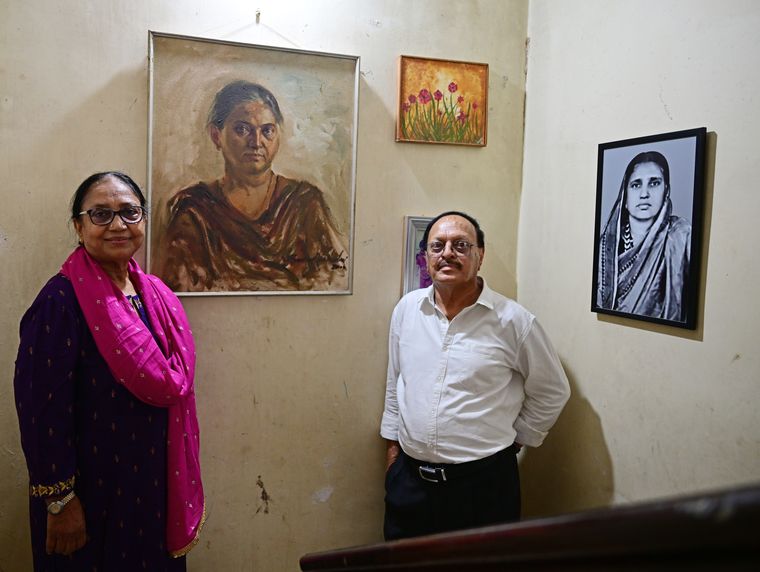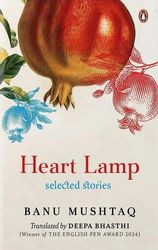The nib of my red ink-filled heart has broken. My mouth can speak no more. No more letters to write. I do not know the meaning of patience. If you were to build the world again, to create males and females again, do not be like an inexperienced potter. Come to earth as a woman, Prabhu!
Be a Woman Once, Oh Lord!
This is a plea from the last story in Kannada writer Banu Mushtaq’s Heart Lamp, a collection of 12 stories, shortlisted for the International Booker Prize 2025. It’s not just a plea, but an indictment of a world built without empathy for the feminine existence.
Mushtaq’s voice is one of grit and fierce honesty. Her stories are simple narratives of complex circumstances in which women from the margins of society find themselves. They have a lyrical appeal, yet ask the toughest questions on freedom, choice and happiness. As an activist, lawyer, journalist and writer, her works are shaped by both experience and an unrelenting commitment to social justice. She confronts the structures that bind women―especially Muslim and dalit women―to lives of marginality, while illuminating their resilience with compassion and clarity.
Mushtaq, 77, always had the urge to write from her student days, but did not know how to go about it. Finally, it was in 1973, a year before her marriage to college senior and distant relative Mushtaq Mohiyuddin, that she wrote her first story ‘Naanu Aparadhiye’ (Am I the Culprit?). However, there was a long break before she took up writing again, an interlude in her life marked by depression and hysteria post marriage. In the 1980s, she finally started writing again after her third daughter Ayesha was born, when she published an article in the Kannada magazine Lankesh Patrike protesting a Muslim woman being forbidden to go to the movies. Since then, she has authored six short story collections, a novel, an essay and a poetry collection.
The stories in Heart Lamp were originally written in Kannada between 1990 and 2023 and translated into English by Deepa Bhasthi. In honouring her work, we are reminded that literature at its most powerful does not just reflect the world as it is; it dares to imagine it as it should be.
Excerpts from an interview:
Q/ When did you publish your first story?
A/ It was published after I got married. I had gone with my father S.A. Rahman, a retired senior health inspector, to visit his friend in Jayanagar in Bengaluru. While they were chatting, I decided to explore the area. As I was walking, I noticed the nameplate of Ma.Na. Murthy, the editor of the newspaper Prajamata Weekly, which I read regularly. I knocked on the door, introduced myself, told him I write stories and wanted one published in Prajamata. He said, “Alright, send it to me.” I was thrilled and asked for the address. He told me I’d find it in the magazine, but I insisted he give it to me directly―just to be sure. He did, and that moment really stuck with me. While returning home I made a neat copy of the story (‘Naanu Aparadhiye’), posted it to him and waited. For almost a year, it was not published. And there was no other story to write also. By then I got married to Mushtaq. After a month of our marriage, we had gone to my maternal home at Belur. He went outside to buy magazines and saw my story published in Prajamata. Excited, he came running to me.
Q/ Did publishing that story encourage you to pursue writing more seriously?
A/ No, I couldn’t write anything because I was married. I was to stay at my in-laws’ home. And they were never happy about me writing. In fact, our marriage was delayed for seven years because I am an educated and working woman. Right after graduation in 1970, I even applied to be an announcer at the Bangalore station of All India Radio. After my marriage it was days of depression and quarrels.
Q/ Is your husband silent and sensible like those in your stories?
A/ I’m a very emotional person, while he is calm. When something happens―an incident or a conversation―I can’t let it go. It stays with me and haunts me. But he always says, “Why are you taking it to heart? It’s none of our business. Just forget it.” He moves on easily, but I can’t. That’s why I end up writing these stories―it’s my way of processing what I can’t forget. He got me to resign my job as a high school teacher within 18 days of marriage. My relatives advised me not to resign. After quitting, I felt sorry and went wild. While returning home I blamed him for it and said some nasty things. He was very understanding. For two years, I was drenched in a pool of regret.
Q/ Is there anything personal about the kerosene episode in Heart Lamp?
A/ Yes. We had a big joint family, and being confined within four walls made me wild. I told my husband, “You’ve spoiled my life.” I was really upset. He was calm and tried to console me. Once, in a fit of despair, I poured white petrol on myself, intending to set myself on fire. Thankfully, he sensed it in time, hugged me, and took away the matchbox. He pleaded with me, placing our baby at my feet saying, “Don’t abandon us.” I realised then what a terrible thing I was about to do. Looking back, it might have been post-partum depression. But it felt deeper, heavier―like something inside me was breaking. Everything in my stories is somewhat autobiographical. That experience made me more empathetic.
Q/ Tell us about your transition to activism and writing.
A/ During the 1980s, there were many social movements that were active in Karnataka. All these movements had healthy demands―they wanted to abolish caste and class hierarchies. I got involved, especially in Hassan, where many of the movement’s leaders were active. I started learning about social structures, Constitutional guarantees, and the plight of marginalised communities.
After my third daughter Ayesha was born in 1981, I had symptoms of hysteria again, which my husband sensed quickly. One day, he brought me various medicines and also a copy of Lankesh Patrike. Reading it was a turning point. At that time, there was an issue involving a high school teacher named Najma Bhangi from Bijapur. A Muslim youth committee dictated that women shouldn’t go to the movies, and when she did, they started harassing her. I was enraged and decided to record my protest. Holding my baby in my lap, I wrote an article questioning whether only a Muslim man has the right to recreation. I sent it to Lankesh Patrike. Within two or three days, it got printed. I was thrilled.
Q/ Most of your characters and plots are from your own neighbourhood―Hassan Pension Mohalla.
A/ We attended many workshops with stalwarts in the Bandaya Sahitya movement (a progressive literary movement in Kannada), and I asked them what I should write about. They told me, “Write about yourself, your surroundings, your mother, your womenfolk, your youth, your mohalla.” That’s when I started to understand that I could write about my own world. Another question was, what names should I use? At that time, Kannada literature was dominated by Hindu male writers. Even the few Muslim male writers didn’t bring in their own roots or perspectives [in their writing]. I started writing about our mohalla and our realities. My ancestors lived in this area, and most of the people around us were friends or relatives. My protagonists were Muslim women, and I began using Muslim names. I wrote creatively, but always in response to the prevailing social conditions. The issues were the same everywhere: women being harassed, tortured, censored, made into the slaves of men.
Q/ Were you contributing articles to Lankesh Patrike at that time?
A/ I was more than a contributor. I was a reporter for 10 years. But while reporting for Lankesh Patrike, I was also writing stories. They were published in Prajavani, Karmaveera, and other major Kannada publications. From 1981, my stories regularly appeared in the special editions and Sunday supplements of Deepavali and Ugadi. But no publisher came forward to publish my works as a book. In 1990, a person named Nagbhushan published my first story collection. My second collection, Benki Male, won many awards, including the Karnataka Sahitya Academy award. The story ‘Black Cobras’ in Benki Male was made into the movie Haseena by Gireesh Kasaravalli in 2004. It won three national awards.
Q/ Most of your stories challenge patriarchy in the Muslim community.
A/ Yes, I have consistently challenged chauvinistic religious interpretations. These issues are central to my writing even now. Society has changed a lot, but the core issues remain the same. Even though the context evolves, the basic struggles of women and marginalised communities continue. I have also been writing about how the media often misrepresents Muslims. I once saw a misleading photo of an elderly man garlanded by a young girl, implying child marriage. But in reality, it was a photo of a Quran teacher and his student after she completed her Quranic studies―a tradition where the teacher is honoured with garlands and gifts. Misrepresentation like this damages perceptions deeply.
Q/ Was there ever an incident where someone tried to stab you because of your writings?
A/ Yes, in 2000, after Benki Male won awards, a fatwa was issued against me because I upheld Muslim women’s right to pray in mosques. One man, a known troublemaker, tried to stab me to gain notoriety. I could have punished him―he was charged under Section 307 (attempt to murder). But my daughter Lubna, who was practising law with me, asked me to forgive him because he kept begging for mercy, saying he had small children. I saw his plight and decided to let him go. Once, he waited outside my office asking for money to buy sweets for his children. My husband laughed, and I gave him 0600, telling him never to show his face again.
Heart Lamp: Selected Stories
By Banu Mushtaq Translated from Kannada by Deepa Bhasthi
Published by Penguin
Price Rs399; pages 216




